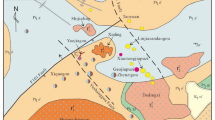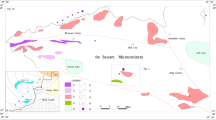Abstract
Miaoershan (MES) uranium ore field is one of the most important uranium sources in China, hosts the largest Chanziping carbonaceous-siliceous-pelitic rock type uranium deposit in South China together with many other granite-hosted uranium deposits. The Shazijiang (SZJ) uranium deposit is one of the representative granite-hosted uranium deposits in the MES uranium ore field, situated in the Ziyuan, Guangxi Province, South China. Uranium mineralization in the SZJ deposit mainly occurs as uraninite with quartz and calcite veins that is spatially associated with mafic dykes in the region. The hydrothermal alteration includes silicification, carbonation and hematitization. New uraninite chemical U-Pb geochronology and petrographic evidences provide the timing constraints and new insights into the formation of the SZJ uranium deposit. The results show that the first stage of uranium mineralization formed at 97.5±4.0 Ma, whereas another stage of uranium mineralization occurred at 70.2±1.6 Ma. Two stages of uranium mineralization are fairly consistent with two episodic crustal extensions that occurred at ~100 and ~70 Ma throughout South China. This study indicates that there are two uranium mineralization events in SZJ uranium ore field controlled by mafic dyke, supporting that mafic dykes play an important topochemical role in uranium concentration and/or mobilization. Therefore, geochemical U-Pb age firstly reinforces that ore-forming age of the SZJ uranium deposit mainly yields at 97.5±4.0 and 70.2±1.6 Ma. Additionally, geochemical age method is particularly useful for interest samples which record information on multi-stage uranium mineralizations in South China.
Similar content being viewed by others
References Cited
Alexandre, P., Kyser, K., Jiricka, D., et al., 2012. Formation and Evolution of the Centennial Unconformity-Related Uranium Deposit in the South-Central Athabasca Basin, Canada. Economic Geology, 107: 385–400
Bowles, J. F. W., 1990. Age Dating of Individual Grains of Uraninite in Rocks from Electron Microprobe Analyses. Chemical Geology, 83(1–2): 47–53
Cameron-Schiman, M., 1978. Electron Microprobe Study of Uranium Minerals and Its Application to Some Canadian Deposit: [Dissertation]. University of Alberta, Edmonton. 343
Chen, Y. H., Chen, Z. Y., Cai, Y. Q., et al., 1997. Space-Time Evolution of Meso–Cenozoic Extensional Tectonics and Distributions of Uranium Mineralization in Southeastern China. Uranium Geology, 13(3): 129–146 (in Chinese with English Abstract)
Cuney, M., 2009. The Extreme Diversity of Uranium Deposits. Mineralium Deposita, 44: 3–9
Cuney, M., Emetz, A., Mercadier, J., et al., 2012. Uranium Deposits Associated with Na-Metasomatism from Central Ukraine: A Review of Some of the Major Deposits and Genetic Constraints. Ore Geology Reviews, 44: 82–106
Deng, P., Shu, L. S., Tan, Z. Z., et al., 2002. Mesozoic Tectonomagmatic Activity and Uranium Metallogenetic Sequence in Mid-Nanling Tectonic Belt. Uranium Geology, 18(5): 257–263 (in Chinese with English Abstract)
Du, L. T., 1982. On the Granite-Type Uranium Deposits. Atomic Energy Press, Beijing. 404 (in Chinese)
Fayek, M., Janeczek, J., Ewing, R. C., 1997. Mineral Chemistry and Oxygen Isotopic Aanalyses of Uraninite, Pitchblende and Uranium Alteration Minerals from the Cigar Lake Deposit, Saskatchewan, Canada. Applied Geochemistry, 12(5): 549–565
Förster, H. J., Rhede, D., Stein, H. J., et al., 2012. Paired Uraninite and Molybdenite Dating of the Königshain Granite: Implications for the Onset of Late-Variscan Magmatism in the Lausitz Block. International Journal of Earth Sciences, 101(1): 57–67
Förster, H. J., 1999. The Chemical Composition of Uraninite in Variscan Granites of the Erzgebirge, Germany. Mineralogical Magazine, 63(2): 239–252
Holmes, A., 1911. The Association of Lead with Uranium in Rock-Minerals, and Its Application to the Measurement of Geological Time. Proceedings of the Royal Society A: Mathematical, Physical and Engineering Sciences, 85: 248–256
Huang, G. L., Yin, Z. P., Ling, H. F., et al., 2010. Formation Age, Geochemical Characteristics and Genesis of Pitchblende from No. 302 Uranium Deposit in Northern Guangdong. Mineral Deposits, 29(2): 352–400 (in Chinese with English Abstract)
Hu, R. Z., Li, C. Y., Ni, S. J., et al., 1993. Research on SCO2 Source in Ore-forming Hydrothermal Solution of Granite Type Uranium Deposits, South China. Science in China (Series B), 36(10): 1252–1262
Hu, R. Z., Bi, X. W., Su, W. C., et al., 2004. The Relationship between Uranium Metallogenesis and Crustal Extension during the Cretaceous-Tertiary in South China. Earth Science Forntiers, 11(1): 153–160 (in Chinese with English Abstract)
Hu, R. Z., Bi, X. W., Peng, J. T., et al., 2007. Some Problems Concerning Relationship between Mesozoic-Cenozoic Lithospheric Extension and Uranium Metallogenesis in South China. Mineral Deopsits, 26(2): 139–152 (in Chinese with English Abstract)
Hu, R. Z., Bi, X. W., Zhuo, M. F., et al., 2008. Uranium Metallogenesis in South China and Its Relationship to Crustal Extension during the Cretaceous to Tertiary. Economic Geology, 103: 583–598
Hu, R. Z., Burnard, P. G., Bi, X. W., et al., 2009. Mantle-Derived Gaseous Components in Ore-Forming Fluids of the Xiangshan Uranium Deposit, Jiangxi Province, China: Evidence from He, Ar and C Isotopes. Chemical Geology, 266: 86–95
Janeczek, J., 1999. Mineralogy and Geochemistry of Natural Fission Reactors in Gabon. Reviews in Mineralogy and Geochemistry, 38: 321–392
Kempe, U., 2003. Precise Electron Microprobe Age Determination in Altered Uraninite: Consequences on the Intrusion Age and the Metallogenic Significance of the Kirchberg Granite (Erzgebirge, Germany). Contributions to Mineralogy and Petrology, 145(1): 107–118
Kotzer, T. G., Kyser, T. K., 1993. O, U, and Pb Isotopic and Chemical Variations in Uraninite: Implications for Setermining the Temporal and Fluid History of Ancient Terrains. American Mineralogist, 78: 1262–1274
Leroy, J., 1978. The Margnac and Fanay Uranium Deposits of the La Crouzille District (Western Massif Central, France): Geologic and Fluid Inclusion Studies. Economic Geology, 73: 1611–1634
Li, X. H., Hu, R. Z., Rao, B., 1997. Geochronology and Geochemistry of Cretaceous Mafic Dikes from Northern Guangdong, SE China. Geochimica, 26(2): 14–31 (in Chinese with English Abstract)
Li, W. W., Wang, G., Cen, W. F., 2010. Geochemical and Chronological Characteristics of Xiangcaoping Granite Pluton in Miaoershan Area. Uranium Geology, 26(4): 215–222 (in Chinese with English Abstract)
Ludwig, K. R., 2005. Users Manual for Isoplot/Ex Version 3.22: A Geochronological Toolkit for Microsoft Excel. Berkeley Geochronological Center, Special Publication, Berkeley. 71
Luo, J. C., Hu, R. Z., Fayek, M., et al., 2015. In-Situ SIMS Uraninite U-Pb Dating and Genesis of the Xianshi Granite-Hosted Uranium Deposit, South China. Ore Geology Reviews, 65: 968–978
Marignac, C., Cuney, M., 1999. Ore Deposits of the French Massif Central: Insight into the Metallogenesis of the Variscan Belt. Mineralium Deposita, 34: 472–504
Merlet, C., 1992. Quantitative Electron Probe Microanalysis: New Accurate Φ (ρz) Description. Mikrochimica Acta, 12: 107–115
Montel, J. M., Foret, S., Veschambre, M., et al., 1996. Electron microprobe dating of monazite. Chemical Geology, 131: 37–53
Min, M. Z., Luo, X. Z., Du, G. S., et al., 1999. Mineralogical and Geochemical Constraints on the Genesis of the Granite-Hosted Huangao Uranium Deposit, SE China. Ore Geology Reviews, 14(2): 105–127
Parslow, G. R., Brandstäitter, F., Kurat, G., et al., 1985. Chemical Ages and Mobility of U and Th in Anatcctites of the Cree Lake Zone, Saskatchewan. Canadian Mineralogist, 23: 543–551
Shao, F., Zhu, Y. G., Guo, H. S., et al., 2010. Nalysis on Geological Characteristics of Uranium Metal Lization and Prospecting Potential in Lujing Ore Field. Uranium Geology, 25(5): 295–300 (in Chinese with English Abstract)
Shi, S. H., Hu, R. Z., Wen, H. J., et al., 2010. Geochronology of the Shazijiang Uranium Ore Deposit, Northern Guangxi, China: U-Pb Ages of Pitchblende and Their Geological Significance. Acta Geologica Sinica, 84(8): 1175–1182 (in Chinese with English Abstract)
Shi, S. H., Hu, R. Z., Wen, H. J., et al., 2011a. Isotope Compositions of Carbon, Oxygen and Sulfur in the Shazijiang Granite-Hosted Uranium Ore Deposit, Northern Guangxi, China and Their Genetic Gignificance. Bulletin of Mineralogy, Petrology and Geochemistry, 30(1): 88–96 (in Chinese with English Abstract)
Shi, S. H., Hu, R. Z., Wen, H. J., et al., 2011b. A Tentative Discussion on Fluid Inclusions in Quartz Veins of Shazijiang Uranium Ore Deposit, Northern Guangxi, China. Mineral Deposits, 30(1): 33–44 (in Chinese with English Abstract)
Shi, S. H., 2011. Ore Geochemistry of the Shazijiang Uranium Ore Deposit, Northern Guangxi, China: [Dissertation]. Institute of Geochemistry, Chinese Academy of Sciences, Guangzhou. 115 (in Chinese with English Abstract)
Suzuki, K., Adachi, M., Tanaka, T., 1991. Middle Precambrian Provenance of Jurassic Sandstone in the Mino Terrane, Central Japan: T-U-Total Pb Evidence from an Electron Microprobe Monazite Study. Sedimentary Geology, 75: 141–147
Suzuki, K., Adachi, M., Kajizuka, I., 1994. Electron Microprobe Observations of Pb Diffusion in Metamorphosed Detrital Monazites. Earth and Planetary Science Letters, 128: 391–405
Suzuki, K., Adachi, M., 1991. Precambrian Provenance and Silurian Metamorphism of the Tsubonosawa Paragneiss in the South Kitakami Terrane, Northeast Japan, Revealed by the Chemical Th-U-Total Pb Isochron Ages of Monazite, Zircon and Xenotime. Geochemical Journal, 25: 357–376
Tian, J. J., Hu, R. Z., Su, W. C., et al., 2010. Ore U-Pb Isochron Ages and Metallogenic Tectonic Setting of No. 661 Uranium Deposit. Mineral Deposits, 29(3): 452–460 (in Chinese with English Abstract)
Xie, X. H., Chen, W. F., Zhao, K. D., et al., 2008. Geochemical Characteristics and Geochronology of the Douzhashan Granite, Northeastern Guangxi Province, China. Acta Petrogica Sinica, 24(6): 1302–1312 (in Chinese with English Abstract)
Xu, W. C., Huang, S. J., Xia, Y. L., 1988. The Study of U-Pb Isotopic Evolutionary System in Chanziping Uranium Deposit. Journal of East China College of Geology, 11(1): 11–21 (in Chinese with English Abstract)
Xu, D. Z., Liu, L. Q., Hu, B. Q., 1999. Study of Pneumato-Hydrothermal High Temperature Uranium Metallogenic Characteristics and Uranium Metallogenic Ages in Xiazhuang Uranium Ore-Fluid. Uranium Geology, 15(5): 266–270 (in Chinese with English Abstract)
Zou, D. F., Li, F. L., Zhang, S., et al., 2011. Ming of No. 335 Ore Deposit in Xiazhuang Uranium Ore Field, Northern Guangdong Province: Evidence from LA-ICP-MS U-Pb Dating of Pitchblende. Mineral Deposits, 30(5): 912–922 (in Chinese with English Abstract)
Author information
Authors and Affiliations
Corresponding author
Rights and permissions
About this article
Cite this article
Luo, J., Hu, R. & Shi, S. Timing of uranium mineralization and geological implications of Shazijiang Granite-Hosted uranium deposit in Guangxi, South China: New constraint from chemical U-Pb age. J. Earth Sci. 26, 911–919 (2015). https://doi.org/10.1007/s12583-015-0542-y
Received:
Accepted:
Published:
Issue Date:
DOI: https://doi.org/10.1007/s12583-015-0542-y




